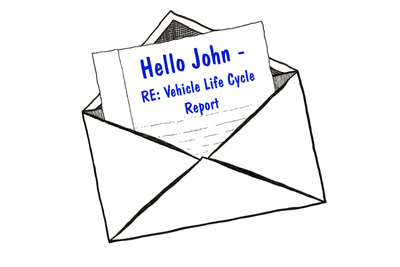Open Letter to John Eichberger and FUELS INSTITUTE
 |
Breaking Down an Erroneous Comparison of Internal Combustion Engine
and Electric Vehicles
and Electric Vehicles
 Marc Rauch |
By Marc J. Rauch
Author of THE ETHANOL PAPERS
Exec. Vice President/Co-Publisher
THE AUTO CHANNEL
Hi John -
Thanks for your email today about the report that FUELS INSTITUTE commissioned to study the cost and emissions life cycle of internal combustion engine vehicles and electric vehicles.
The report looked interesting, and I was excited to see that it was authored by Ricardo Strategic Consulting, one of the few entities I would say is capable of presenting a legitimate objective assessment of this subject matter. (CLICK HERE to download the full report.)
Unfortunately, I was troubled by some aspects of the report.
The first is that in the conclusions, electric vehicles (both hybrid and battery) are presented in best-case scenarios, while the internal combustion engine vehicles are relegated to less-than-best case scenarios. What I mean by this is that costs for battery replacements are not calculated in, nor are the costs for replacement shown for comparative purposes. I'm aware that there is a disclaimer that the cost of battery replacement is not calculated in, but the disclaimer is not sufficient to tell the true story. In the lifespan of an electric vehicle, the battery will have to be replaced, and the costs of such replacement can run from $10,000 to $20,000. This cost, added to the shown life cycle costs for electric vehicles presents an entirely different outcome, one that is not favorable to EVs.
The second troubling aspect is that the gasoline fuels used in the analysis of the internal combustion engine vehicles were only low ethanol-gasoline level blends (E10 and E15). There were no estimates given for any higher blends, such as E30, E85, or even the mandated Brazilian blend of E27. This inclusion of these blends would have presented a significantly different picture in the cost comparison conclusion, as well as in the emissions comparison conclusion.
The folks at Ricardo should know better than most people that every single spark-ignited internal combustion engine vehicle on the road (regardless of age and manufacturer) can safely and efficiently use ethanol-gasoline blends that are much higher than E10 and E15. And every single fuel-injected spark-ignited internal combustion engine vehicle with an onboard computer can use E85 (regardless of whether the vehicle is flex-fuel rated or not). At the most, a simple inexpensive computer software update would make all of these vehicles "flex-fuel" vehicles.
An emissions calculation taking into account the use of the higher ethanol-gasoline blends would have shown ICE vehicles to be as clean or cleaner than any battery-electric vehicle.
Moreover, any hybrid electric vehicle using a higher ethanol-gasoline blend would have significantly lower life cycle cost and emissions results.
When General Motors originally announced the Volt, which for all practical purposes ushered in the new era of electric vehicles, the onboard charging engine was supposed to be a flex-fuel engine. Ultimately, they wimped out and did not officially declare it a flex-fuel engine. This was a terrible mistake on their part, but then GM has a history of bad decisions. I mention this because if GM had declared the Volt's charging engine to be flex-fuel, I believe that all other automakers would have followed and declared their hybrids to be flex-fuel. And as my business partner (Bob Gordon) always said, "A hybrid running on E85 could claim to get something like 200 or 300 miles per gallon of gasoline" - extrapolating out the use of an electric motor with an internal combustion engine using just 15% gasoline in the E85 blend.
In addition, there remains another horrendous element to electric vehicles: The mining of the materials needed to make the batteries. Perhaps, one day, the batteries will not require the materials that they do now. But at this time, children and adults in Africa are being used to dig for the materials under terrible conditions. This aspect alone should put an end to the entire issue of using lithium batteries to power vehicles. I can't help but think that if little black children were being used under similar conditions to plant and harvest corn or sugar that the oil industry and every socially-conscious organization in the world would be screaming their heads off against ethanol.
Therefore, in the final analysis, I feel that your report has done more harm than good in trying to explain electric vehicles and helping to make the world a cleaner and better place.
If you feel I have missed salient points in the reports (and I imagine that you will), I would gladly receive and review that information with great earnest. And if earnest isn't available, I'll get his brother henry (sorry, but I had to throw in some levity).
Sincerely yours,
Marc J. Rauch
SEE ALSO:
• The Real Story On Electric Vehicles
• I Just Saved 38% on a Fill-Up By Using E85 - You Can Too!
• Publishing False & Alarmist Stories In Place of Accurate Well Researched Reports Is Detestable
• Ethanol-Basher Scores 100%...in Idiocy
• Open Letter to William T. Alpert on His Fraudulent Anti-Ethanol Article


